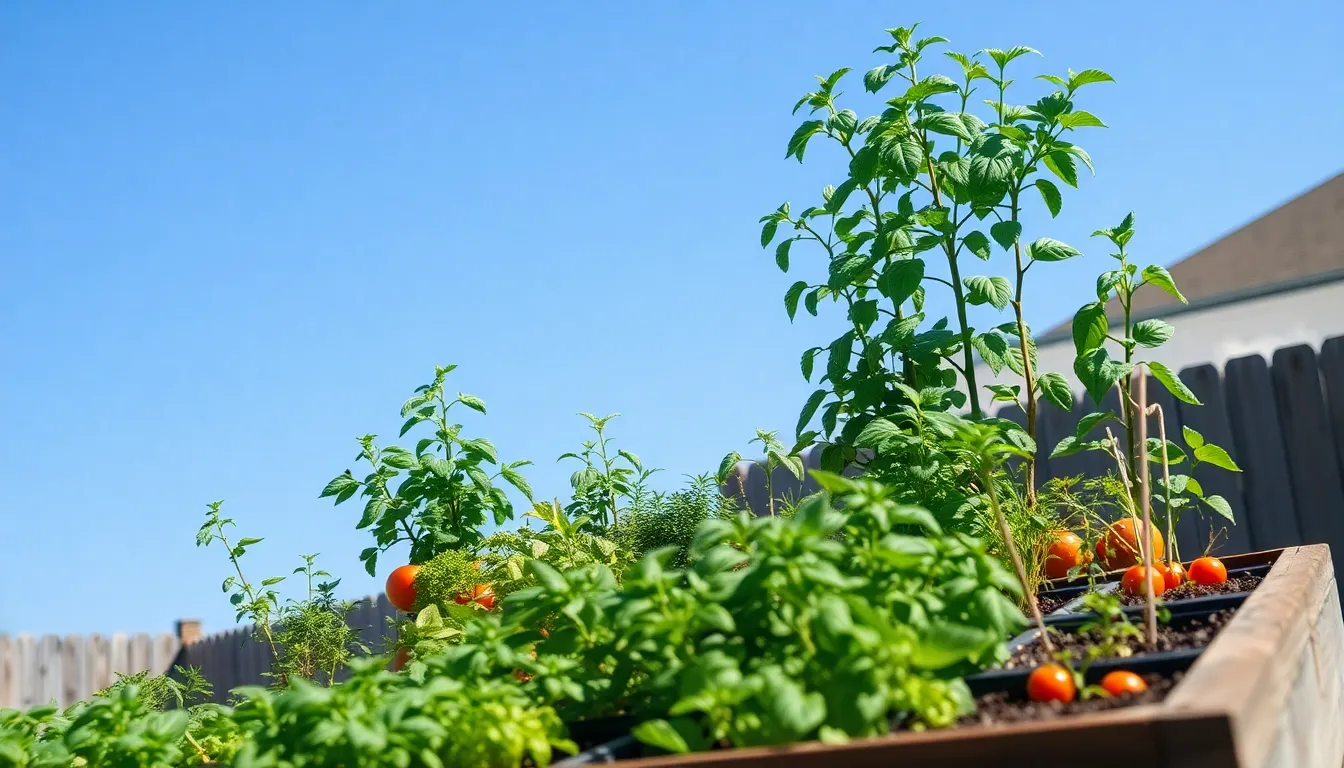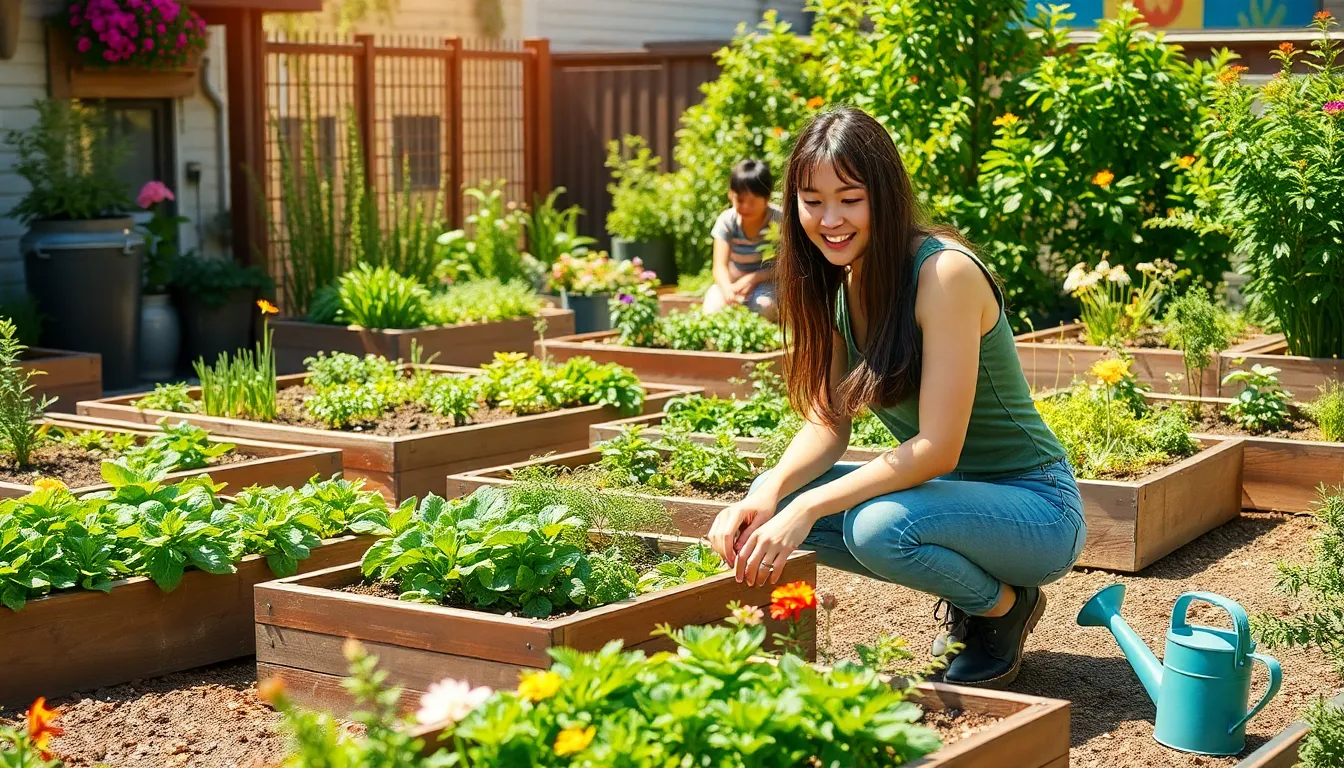Imagine transforming a tiny patch of earth into a lush, bountiful garden without needing a PhD in botany. That’s the magic of square foot gardening! With its simple, organized approach, anyone can grow their own vegetables, herbs, and flowers in just a fraction of the space. No green thumb required—just a little planning and a handy square foot gardening chart.
Table of Contents
ToggleOverview of Square Foot Gardening
Square foot gardening is a highly efficient method for growing a variety of plants within a small area. This gardening technique divides the garden bed into square sections, making it easier to manage and organize plant growth. By utilizing a square foot gardening chart, gardeners can maximize the yield per square foot, ensuring optimal use of space.
This approach focuses on growing vegetables, herbs, and flowers together, promoting companion planting and improving overall health. Each square can host different crops, enhancing biodiversity and reducing the risk of pests. Planning becomes straightforward with clear guidelines indicating how many plants can fit into each square.
Timing is crucial in square foot gardening. Gardeners must consider the growing seasons for each plant type to ensure successful harvests. Selecting the right plants based on their growth habits and spacing requirements contributes to a thriving garden landscape.
In addition, this method aligns with sustainable gardening practices. By reducing the need for expansive garden spaces, square foot gardening conserves water and uses fewer resources overall. It’s suitable for urban dwellers and those with limited outdoor areas, proving that gardening can be accessible to anyone.
Utilizing a chart simplifies the process further. The chart provides information on plant compatibility, spacing needs, and estimated yields, acting as a visual reference for planning. Gardens become manageable rather than overwhelming, enabling more people to enjoy the benefits of homegrown produce.
Benefits of Using a Square Foot Gardening Chart

Using a square foot gardening chart offers numerous advantages for gardeners. One significant benefit focuses on maximizing space efficiency.
Maximizing Space Efficiency
Square foot gardening optimizes planting arrangements. Each square foot section accommodates specific plants, ensuring no area goes unused. Gardeners enjoy a higher yield in smaller spaces, making this approach ideal for limited outdoor areas. Rotating crops among squares prevents soil depletion. This method allows for more diverse produce varieties in compact plots, facilitating various crop combinations. Ultimately, gardeners achieve better organization and growth management through effective use of space.
Simplifying Planting Decisions
Planting decisions become easier with a square foot gardening chart. Specific guidelines provide information about compatible plants. Gardeners refer to spacing recommendations to avoid overcrowding. Choosing which plants to grow becomes convenient, allowing for thoughtful companion planting. Clarity in planting options minimizes confusion during the gardening process. By following these charts, gardeners make informed choices that promote plant health. This structured approach helps ensure a successful garden experience, further enhancing enjoyment and efficiency.
Understanding the Square Foot Gardening Chart
The square foot gardening chart serves as a valuable tool for optimizing garden layout and plant selection. It organizes plant growth efficiently and enhances productivity.
Layout and Grid System
A square foot garden utilizes a simplified grid system. Gardeners divide the garden bed into square sections, typically measuring 12 inches by 12 inches. Each square accommodates specific plants based on their spacing requirements. Placing different crops within these squares maximizes the available space. Color-coding the squares can further aid in quickly identifying plant types. This organized layout leads to effective management of resources and can prevent overcrowding. Effective use of squares ensures balanced growth and healthy plants while simplifying maintenance tasks.
Recommended Planting Choices
Selecting the right plants is crucial for maximizing yields in square foot gardening. Popular choices include spinach, bush beans, and carrots, each fitting well within a square. Herbs like basil and cilantro thrive in small spaces, complementing vegetable plots. Companion planting enhances biodiversity, improving pest resistance and crop health. Utilizing the chart helps novice gardeners understand proper spacing and compatibility among plant species. Tomatoes and peppers benefit from support structures, making them suitable for corner squares. Overall, the chart guides gardeners toward successful plant combinations, enhancing harvest quality.
Tips for Successful Square Foot Gardening
Successful square foot gardening hinges on effective techniques and proper planning. By focusing on critical aspects like soil quality and watering, gardeners can enhance their productivity.
Soil Preparation and Quality
Soil serves as the foundation for healthy plants. Selecting a high-quality mix that retains moisture yet drains well is essential. Organic matter, such as compost, enriches soil, providing necessary nutrients. Testing soil pH can reveal if any adjustments are needed. A balanced blend typically includes equal parts of peat moss, vermiculite, and compost. Mixing these ingredients thoroughly ensures uniform distribution of nutrients. Following these guidelines fosters strong root systems and promotes vigorous growth.
Watering and Maintenance Strategies
Watering strategies play a vital role in the success of square foot gardening. Consistent moisture encourages optimal plant health, while deep watering promotes root depth. Recognizing the water needs of different plants prevents over- or under-watering. Drip irrigation systems or soaker hoses allow for efficient water delivery. Regularly checking soil moisture levels helps maintain consistency. Mulching around plants conserves moisture and suppresses weeds, reducing maintenance efforts. By employing these methods, gardeners can achieve lush, productive squares throughout the growing season.
Common Mistakes to Avoid
Many gardeners overlook proper spacing when planting, causing overcrowded squares that hinder growth. Regularly check companion planting guidelines to prevent unintentional competition among plants. Ignoring the recommended plant types for specific squares can lead to poor yields and wasted space.
Neglecting soil quality is another frequent error. Soil preparation must include a balanced mix of peat moss, vermiculite, and compost for optimal nutrient distribution. Gardeners often underestimate the importance of moisture, resulting in under- or overwatering. Consistent moisture levels are crucial for healthy plant development.
Failing to monitor plant health is also common. Regularly inspect plants for pests and diseases to address issues promptly. Timing plays a significant role; planting at the wrong season can affect harvest success. Gardeners should refer to a planting calendar aligned with local climate conditions.
Many individuals forget about crop rotation, which can deplete soil nutrients over time. Rotating plant varieties in different squares ensures sustained soil fertility. Another aspect often ignored is record-keeping. Maintaining a garden journal helps track what worked and what didn’t, benefiting future gardening endeavors.
Lastly, there’s a tendency to plant too late or too early. Understanding specific plant growth cycles prevents missed harvests. By avoiding these mistakes, gardeners can enhance their square foot gardening experience, achieving more productive and enjoyable results.
Square foot gardening offers a practical solution for anyone looking to grow their own food in limited spaces. By utilizing a square foot gardening chart, gardeners can effectively plan their layouts and maximize yields while ensuring healthy plant growth. This method not only simplifies the gardening process but also promotes sustainable practices that benefit both the gardener and the environment.
With careful attention to plant compatibility and spacing, along with a focus on soil health and moisture levels, anyone can create a thriving garden. By avoiding common pitfalls and following best practices, square foot gardening can transform even the smallest of spaces into productive and enjoyable gardens. Embracing this method opens up a world of possibilities for urban gardeners and enthusiasts alike.



